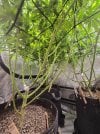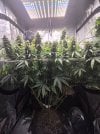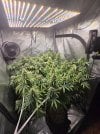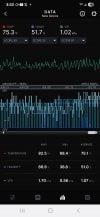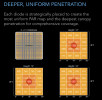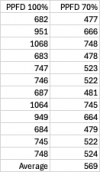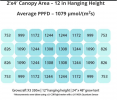Got it. The PPFD meter is converting lux to PPFD for you.
800-1k is textbook "light saturation point" for cannabis. You must be running that light at/close to 100% but the light doesn't have a great PPFD map. It's got a lot of light in the center but the light levels fall of pretty quickly as you move off center. That's just how board lights work. Well, the vast majority of them, anyway.
The light you're using is 240 watts and the grow area is 9 square feet. That works out to <27 watts/ square foot. Input wattage is not an indicator of how much light a grow light will generate but it is close enough to be a good guide. And 27 watts per square foot is on the low side. If you're looking for more growth, you'll have to bring more light.
View attachment 5474321
The S33 is a board light and, like all board lights, has a "hot spot" in the center of the PPFD map. Regardless of the hang height, there is a dramatic PPFD fall off when you move off center. In the 14" PPFD map, for example, the 18" square area in the center has a PPFD of ~1300µmol. That's too high to be usable in ambient CO2, so growers will drop the input wattage. If the input wattage drops to 70%, the center are of the light is generating ~ 920µmol (most growers don't give their plants that much light but I'm using this as an example). When the input wattage is reduced to 70%, the PPFD for the grow area around the periphery is likewise reduced. In this case, the 920µmol in the center area how has a band of PPFD's around the edges will be about the values in this table:
View attachment 5474322
In short, you've got good light in the 4 center squares but the other 12 squares are averaging only 569 and, if you knock out the two spots that are >1000µmol, the average is only 534µmol.
And that's the best case because the PPFD map that AC Infinity uses is not "industry standard". They're using a 9" grid (most sites use a 6" grid) and the larger grid will tend to increase the values.
I uploaded the spectrum chart for this light to Grok and asked it to do a spectral analysis. Per the values below, the light has quite a bit of blue in the spectrum. Blue photons keep plants short and bushy and plants will tend to have a lot of leaves and lots of branches. That's what I see in the pictures that you've posted.
| Wavelength Range | Approximate Percentage (%) |
|---|
| Blue (400nm-500nm) | 30-35% |
| Yellow-Green (500nm-600nm) | 25-30% |
| Red (600nm-700nm) | 35-40% |
| Far-Red (700nm-880nm) | 5-10% |
My belief is that the reason that you're seeing smaller buds is because of the high percentage of blue in the spectrum and because of the limited amount of light that the S33 puts out (except in the center). It's a fact that blue photons decrease internodal space and that's one reason why buds "stack". But the reason that they didn't stack is that there is an unusually high percentage of blue but, more important, there simply wasn't enough light hitting the canopy to get the desired growth.
There is a simple remedy—add more light and add more red light.
Last summer, I spent some time looking for a replacement for my Growcraft X3 flower light. It was an excellent light in its day but it was designed in 2019 and I was hoping to find a newer light that would have a better PPFD map. After a couple of weeks of searching, I gave up. Even though it's an old design, it was a very good product and there was (and still is) nothing that I can find to replace it in the 2' x 4' market.
Though it's not as pronounced as the S33, the X3 generates 1300µmol in the center and >1200 just outside that but if I turn down the dimmer so that PPFD is 1k in the center, there's a 1' strip on either end of the grow area where light levels will be pretty low.
View attachment 5474323
A grower on another forum suggested that I look into supplemental lighting and that turned out to be the solution.
I ended getting a pair of Spider Farmer GlowR80 lights. They're 40 watts each and, at 12" hang height, they add about 290µmol of 660nm red light. That was a significant improvement. It smoothed out the PPFD map, allowed me to reduce the input wattage to my Growcraft by 150 watts, and I ended with more red photons (better growth) at an ambient temperature that is 2° lower than it was with the Growcraft.
The big win that you'll get is that you'll get a more even PPFD map, so you'll get a more even light cast across the entire grow area and, second, since it's 660nm light, you'll be able to reduce the % of blue light in the spectrum. I've attached a paper from Bugbee et al re. the impact of blue light on yield.
I have no affiliation with Spider except as a customer.
[time passes]
I spent some quality time with Grok and I think that change will do very well for you. The link to the analysis is
here.

